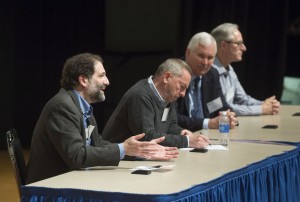
P5 Committee Chair Steve Ritz, left, addresses a question from the audience at Fermilab’s 2014 Users Meeting. Image: Reidar Hahn
The P5 report was approved by the HEPAP meeting on May 22. As a new HEPAP member, I participated in discussions on the report, even though I had to call in from Japan. The news was already covered in the Director’s Corner by Harry Weerts and Mike Harrison. But I’d like to write about my take on the importance of the report and its expected positive impact on the ILC.
The High-Energy Physics community in the United States went through a year-and-a-half long process to come up with “an updated strategic plan for U.S. High Energy Physics that can be executed over a 10 year timescale, in the context of a 20 year global vision for the field.” ILC came out as a big part of the US strategy.
P5 stands for Particle Physics Project Prioritization Panel that reports to HEPAP, the High-Energy Physics Advisory Panel to the US Department of Energy and National Science Foundation. I was on a panel that recommended the creation of P5, which was meant to be a steward of the changing priorities in high-energy physics as new inputs emerge from cutting-edge experiments. However, there has been no P5 since the last panel produced its report in 2008. Meanwhile, the landscape of high-energy physics changed tremendously. A Higgs boson is discovered, the third neutrino mixing angle of θ13 is found to be as large as anybody could imagine, while the Large Hadron Collider has not (yet) seen any signs of physics beyond the standard model.
The US community, supported by the Division of Particles and Fields of the American Physical Society, embarked on the “Snowmass process,” which in 2013 had a different structure from the past ones. Because the funding agencies did not allow for a monolithic workshop in Snowmass, Colorado, that typically lasted for three to four weeks for everybody to talk to each other, many smaller workshops took place from December 2012 through August 2013 focused on one of the three “Frontiers,” Energy, Intensity, or Cosmic. Despite the new structure, the community dreamed, argued, studied, and presented vision of an exciting future for the field.
ILC was discussed heavily in the workshops for the Energy Frontier, together with the physics prospects at the high-luminosity LHC (HL-LHC), CLIC, a muon collider, and future hypothetical circular colliders in a 50- to 100-km tunnel. It was quickly recognised by the community that the ILC is the only viable option besides the HL-LHC in the foreseeable future, thanks to the detailed work on the Technical Design Report (TDR) by the Global Design Effort (GDE) led by Barry Barish. If we keep our eyes on a new collider taking data before 2030, aimed at precision study of the discovered Higgs boson and the top quark as well as searching for new physics from electroweak processes, ILC uniquely fits the bill. Chip Brock, a co-convener for the Energy Frontier working group, concluded, “This Higgs Boson changes everything. We’re obligated to understand it using all tools.” and said, “To me, it’s the ILC.” William Barletta, representing the Capabilities Working Group added, “U.S. accelerator community is capable to contribute” to the ILC and “We are experienced & ready to do it.”
The P5 took over where the Snowmass process left off. The Snowmass process is a grass-roots process, dreaming what the community wants to do, without a reality check on what programme would fit within the anticipated budget envelope. P5 had to face the funding reality and make difficult choices. It was given three budget scenarios, A, B, and C. The scenario A is quite gloomy. B is better but still tight. C is “unconstrained” but within reason. I couldn’t help notice that this is the opposite order from grades I give to students when I teach in Berkeley. I smelled trouble.
Yet, Steve Ritz from UC Santa Cruz did a fantastic job in responding to the charge. He as the chair of P5, together with the HEPAP chair Andy Lankford from UC Irvine, assembled a committee of excellent scientists, including two from Europe and two from Japan. It is remarkable that they came up with their report based on consensus. Steve told me that they kept discussing recommendations until there was no single person against. This time-consuming process was successful. Amazing.
The P5 report has 29 (!) recommendations. But the report is relatively short and crisp, and it is definitely worth reading. As clear from the title, “Building for Discovery –– Strategic Plan for U.S. Particle Physics in the Global Context”, it correctly emphasises the global nature of our field. It lists five science drivers:
- Use the Higgs boson as a new tool for discovery
- Pursue the physics associated with neutrino mass
- Identify the new physics of dark matter
- Understand cosmic acceleration: dark energy and inflation
- Explore the unknown: new particles, interactions, and physical principles.
In view of these science drivers, they commented on various collider options. For obvious reasons, they said “The LHC upgrades constitute our highest-priority near-term large project.” They also recommended to “Pursue accelerator R&D with high priority at levels consistent with budget constraints”. On the other hand, they decided to “Reassess the Muon Accelerator Program (MAP).”
The report evaluated the physics case of ILC to be “extremely strong.” In particular, “The ILC would then follow the HL-LHC as a complementary instrument for performing these studies in a global particle physics program, providing a stream of results exploring three of our Drivers for many decades.” The three drivers here refer to discovery through Higgs, dark matter, and the unknown. Remember the funding for the ILC in the U.S. was zeroed out after the completion of the TDR. Concerning this, P5 said “we plan in all Scenarios for ILC support at some level through a decision point within the next five years.” This is big. U.S. can restart investment in the ILC.
Obviously, how much U.S. can contribute to the ILC construction and operation would depend on the budget scenario. Their recommendation on the ILC is very clear and positive. “Motivated by the strong scientific importance of the ILC and the recent initiative in Japan to host it, the U.S. should engage in modest and appropriate levels of ILC accelerator and detector design in areas where the U.S. can contribute critical expertise. Consider higher levels of collaboration if ILC proceeds.” I could not have expected a stronger recommendation that this.
Jim Siegrist, the director of the Office of High-Energy Physics (OHEP) of the US Department of Energy, is already at work trying to implement the report. At the Fermilab Users’ Meeting on 11 June, Jim said “The meaning of ‘modest’ will depend on the HEP budget.” The initial support will be by redirection of effort. He said it was in general not easy to redirect effort because he had to move people around, yet he would start working on it. The next point was “The meaning of ‘appropriate’ will depend on the areas where Japan would like us to help.” His understanding was that the current priority was for site-specific R&D and design, which I believe is true. Finally he said “We would await further discussions with the Japanese government.” Actually, the MEXT Minister Shimomura wrote a letter to the Energy Secretary Moniz to discuss the ILC further; it should help keep the ball rolling.
I keep hearing from him and other agency people that the report was received well in Washington DC. The President’s budget proposal for OHEP was grim, but the hopes are high that the good reception of the report may result in positive mark-ups in the Congress. More importantly, OHEP can allocate funds to restart the work on the ILC in the US.
Welcome back, USA!


Recent Comments